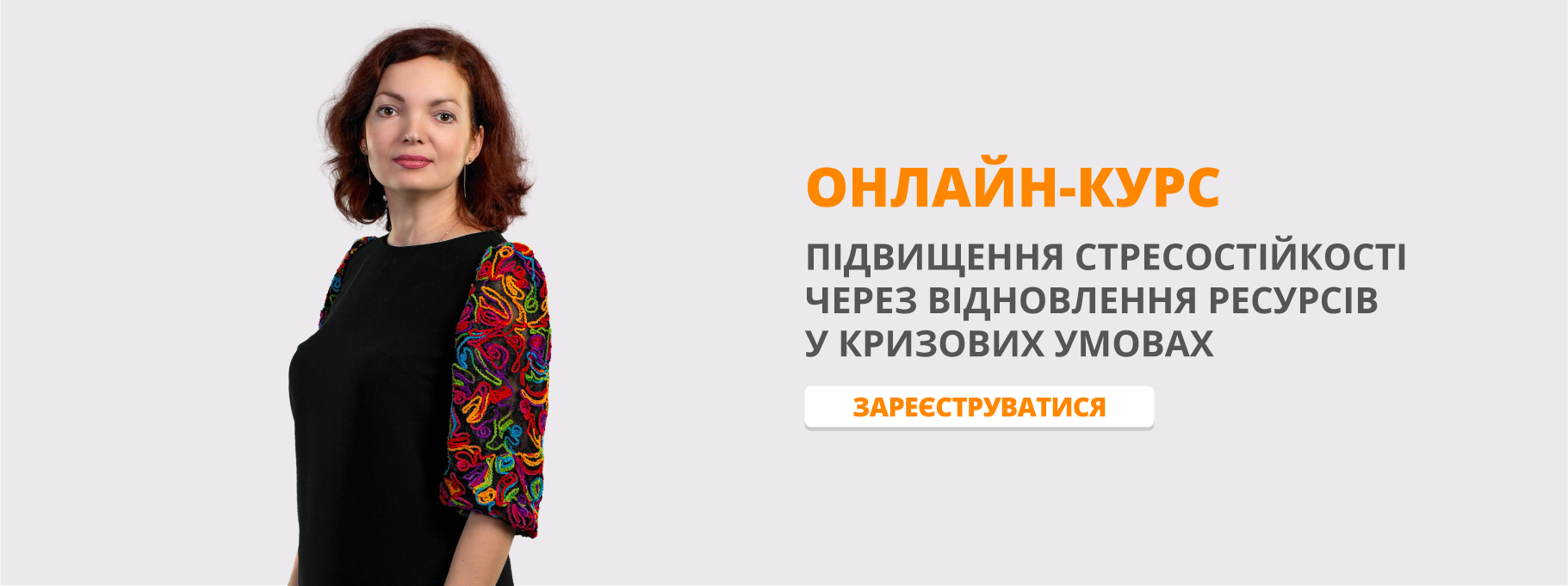Збірник текстів для читання про Україну
UKRAINE – Land of Contrasts
1 Ukraine is a land of contrasts, from north to south and east to west, in geography, language and culture. It is one of the largest countries in Europe, but has a population about 40 million people, meaning that it is easy to find quiet and natural places where you can unwind.
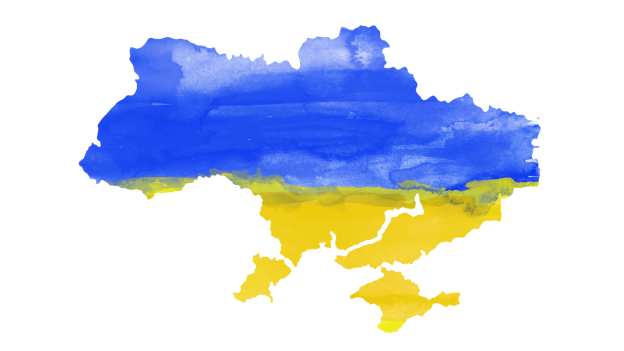
Important Information and Statistics
On August 24th , … , Ukraine proclaimed its independence from the USSR and began to construct a democratic state. This was a historic moment for Ukraine, as for many years its independence and culture had been in danger. Since the collapse of Kyivan Rus, present day Ukraine had been under pressure from Tatar, Polish and Turkish invaders, all of them attempting to bring the people and land under one role. This threat was reduced with the reunification of Ukraine and Russia in … . This event happened at the Pereyaslav Rada under Bohdan Khmelnytsky’s guidance. For more than … years Ukraine was part of Russia, and in … its central, southern and eastern parts belonged to the Soviet Union. The western part of Ukraine was joined to the USSR in … .
Ukraine is the second largest country in Europe with an area of … square kilometres. Historically and ethnically, Ukraine’s territory is divided into … zones: Polissia in the North, Serednia Prydnipryanshchyna along the central part of the Dnipro River, Podillia in the South-West, along the rivers Pivdenny Buh and Dnister, Slobozhanshchyna in the East, Volyn in the North-West, The Carpathians and Bukovyna in the West and Crimea in the South.
According to the Constitution of Ukraine, the territorial structure of the country is composed of … oblasts (regions) and the Autonomous Republic of Crimea, with further subdivision into rayons (districts), cities, settlements and villages. The capital of the country is the ancient city Kyiv.
Task I. Read and fill in the gaps with the following figures.
-
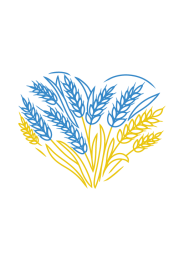 1654; 1939; 8; 24; 1991; 1922; 603,700; 250.
1654; 1939; 8; 24; 1991; 1922; 603,700; 250.
Task II. Choose the right answer
1. Ukraine proclaimed its independence from the USSR … .
A) on August 24th,1990;
B) on August 24th , 1991;
C) on December 1st , 1991;
2. The reunification of Ukraine and Russia happened at the Pereyaslav Rada under…
A) Ivan Mazepa;
B) Mykhailo Hrushevsry;
C) Bohdan Khmelnytsky;
3. Ukraine is the … country in Europe.
A) the second largest;
B) the largest;
C) the smallest;
4. Historically and ethnically Ukraine’s territory is divided into … zones/
A) 8;
B) 6;
C) 4;
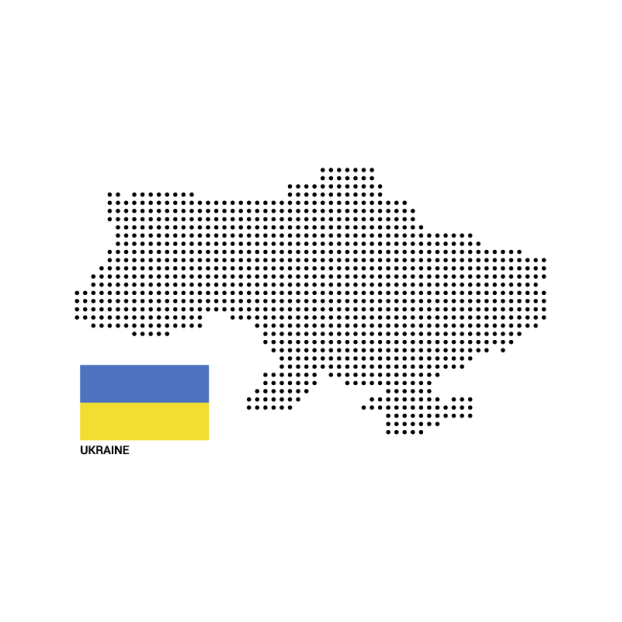 5. The territorial structure of the country is composed … regions and the Autonomous Republic of Crimea.
5. The territorial structure of the country is composed … regions and the Autonomous Republic of Crimea.
A) 14;
B) 20;
C) 24;
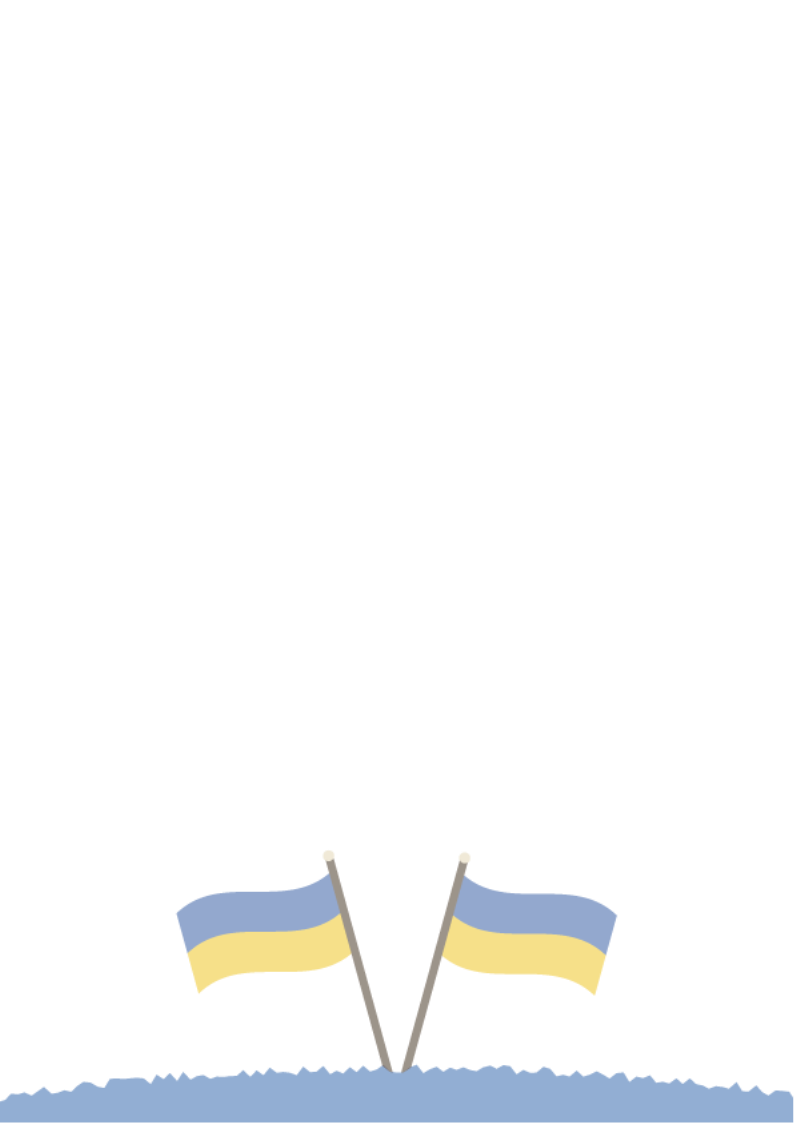 The Structure of the National Government
The Structure of the National Government
Under the Constitution, the powers of the government are divided into three branches the legislative, which consists of the Verkhovna Rada (the Ukrainian Parliament), the executive, headed by the President with the Cabinet of Ministers as the highest body and the judicial, which is led by the Supreme Court.
The Parliament has one house that is represented by 450 people’s deputies, elected for four year term by the citizens of Ukraine. The Verkhovna Rada’s main function is making laws.
The President is elected directly by the voters for the term of five years, with no more than two full terms. The President of Ukraine secures state independence, human rights and freedoms. The executive power in regions and districts is exercised by local state administrations. Their heads are appointed by the President and are responsible to him.
Justice in Ukraine is exercised entirely by the courts. It is administered by the Constitutional court and by courts of general jurisdiction. The Supreme Court of Ukraine is the highest body of general jurisdiction.
Read the sentences below and mark them T (True) or F (False). Correct the false ones.
1. The executive power is headed by the Supreme Court. ……
2. The Verkhovna Rada’s main function is making laws. ……
3. The Prime Minister secures state independence, human rights and freedom. …...
4. The heads of the local state administrations are elected by the people. ……
5. The President is elected by the voters for the term of four years. ……
6. The Parliament has two houses. …….
7. 350 people’s deputies are elected for four year terms by the citizens of Ukraine. ……
8. The Supreme Court of Ukraine is the highest body of general jurisdiction. ……
Kyiv – the Capital of Ukraine
Kyiv is one of the oldest cities in Europe and therefore there are a lot of places of historic interest in it. Its history goes back to the 5th century. In 882 Prince Oleh the Seer defeated the Kyiv Princes Askold and Dir and brought the Slavic tribes of Eastern Europe together. He is recorded as saying “let Kyiv be the Mother of Rus cities”.
Kyiv is situated on the banks of the Dnipro river, the longest river in Ukraine. The picturesque banks and hills, plentiful flower-beds with different flowers, wonderful beaches of the Dnipro river, Khreshchatyk, one of the widest and most beautiful streets in our country – all this adds up to the beauty of the Ukrainian capital.
Among the places of historic interest is St. Sophia’s Cathedral – the unique masterpiece and the top of the creative spirit of the Ukrainian people. Kyiv-Pechersk Monastery, another ancient monument, stands on a green hill above the Dnipro river and its sparkling gold cupolas can be seen outside the capital. St. Volodymyr Cathedral, Church of St. Andrew, Golden Gates, Vydubetsky Monastery, Askold’s Grave and many other ancient monuments attract attention of visitors. Other historical relics in the central area include the ruins of the Golden Gate, also built in the 11th century in the reign of Yaroslav.
The axis of the centre is the street known as Khreshchatyk. The greenery of the gardens, the trees lining the street, the squares that it intersects give Khreshchatyk an attractive and colourful aspect much admired by Kyiv’s inhabitants. Perhaps the most notable public square along Khreshchatyk is Maidan Nezalezhnosti (“Independence Square”). It served as the centre of the Maidan (also called Euromaidan) protest movement . Among important buildings on the street is that of the city council, where the elected deputies hold their meetings.
The monument to Taras Shevchenko, the great poet of Ukraine, is in front of the Kyiv National University, named after him. The monument to Bohdan Khmelnytsky, a Ukrainian national hero, stands in the square opposite St. Sophia Cathedral.
During its long and rich history Kyiv suffered from different invasions. And nowadays our capital continues its struggle for freedom and independence. On the 24th of February 2022 Putin announced the beginning of a “special military operation” against Ukraine, and cruise missile strikes preceded a large-scale invasion of Ukrainian territory. The Ukrainian military checked the Russian advance at multiple points, however, and thousands of civilians took up arms to defend the capital.
Ukrainian people love their capital city and are proud of it.
Task I. Match the highlighted words to their synonyms:
outstanding, beautiful, old time, marvelous, pictorial, extensive, striking, shining, unusual, abundant
Task II. Complete the sentences using the words and phrases:
notable, unique, ancient, goes back, picturesque, monuments, large-scale invasion, places of historic interest, plentiful, wonderful.
1. Kyiv is very old city therefore there are a lot of_________ in it.
2. The history of the capital ________ to the 5th century.
3. The ________ banks and hills, ________flower-beds with different flowers, _________ beaches of the Dnipro river – all this adds up to the beauty of the Ukrainian capital.
4. St. Sophia’s Cathedral is the ________ masterpiece and the top of the creative spirit of the Ukrainian people.
5.The ________ monument of Kyiv-Pechersk Monastery stands on a green hill above the Dnipro river.
6.The most ________ public square along Khreshchatyk is Maidan Nezalezhnosti (“Independence Square”).
7. The ________ of Ukrainian territory with russian troops began on the 22nd of February 2022.
Kyivan Rus
A ___ In the 12th century, feudal conflicts split Kyivan Rus into fifteen principalities and lands.
B ___ In 882 Prince Oleh the Seer defeated the Kyiv Princes Askold and Dir and brought the Slavic tribes of Eastern Europe together. He is recorded as saying “let Kyiv be the Mother of Rus cities”.
C ___ In the 8th and 9th centuries Kyivan Rus expanded and developed and later became one of the largest and mightiest of medieval powers. It was populated by the Slavic tribes of Polyans, Drevlyans, Siverians, Dulibs, White Croats, Tyvetsi and Ulyches. It occupied a vast territory – from the Baltic Sea to the Black Sea and from the Carpathian Mountains to the Volga River.
D ___ In 1240 Tatar-Mongols captured Kyiv and kept it under control for almost three centuries.
E ___ In 988 Prince Volodymyr introduced Christianity as a official state religion in Kyivan Rus and ordered the destruction of all pagan idols.
F ___ In 913 after Prince Oleh the Seer’s death, Ihor the Elder and his wife Princess Olha joined the Drevlyans; land (the north of today’s Ukraine) to Kyivan Rus. It was done at the expense of Prince Ihor’s life. As revenge Princess Olha burnt the town Iskorosten to ashes.
G ___ In the 11th century under the rule of Prince Yaroslav the Wise, Kyivan Rus became a major factor in European politics.
Task I. Read the text and put the paragraphs in historical order. Start with the earliest.
 Task II. Match the words in bold to their definitions.
Task II. Match the words in bold to their definitions.
A Groups of people who live together and have a traditional way of life.
B The most powerful and successful.
C To break into parts or groups.
D Punishment given to someone who has done something bad to you.
E A place ruled by a prince.
D To have lost in a fight or competition.
Task III. Complete the sentences.
1. Kyivan Rus stretches from … to … .
2. … defeated Kyiv Princes Askold and Dir and brought the Slavic tribes together.
3. Ihir the Elder and his wife Princess Olha … .
4. … introduced Christianity in Kyivan Rus.
5. … under the rule of Prince Yaroslav the Wise.
6. … captured Kyiv in … .
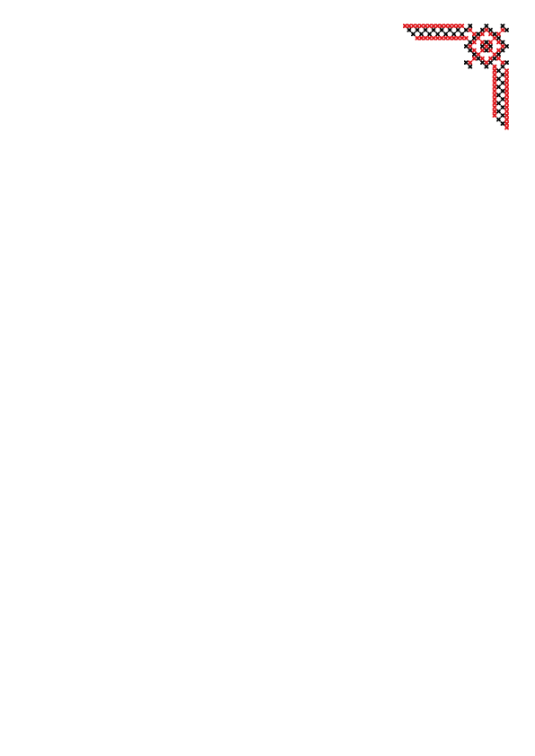 Vyshyvanka: More than Fashion
Vyshyvanka: More than Fashion
A ____ The word “vyshyvanka” is quite new but the art of embroidery goes back to Scythian times. We know from old books that embroidery is one of the oldest forms of decoration. However, it isn’t as old as the art of making clothes. People learnt to sew and knit before they started to decorate their clothes with different patterns. To do this they used needles, threads and beads.
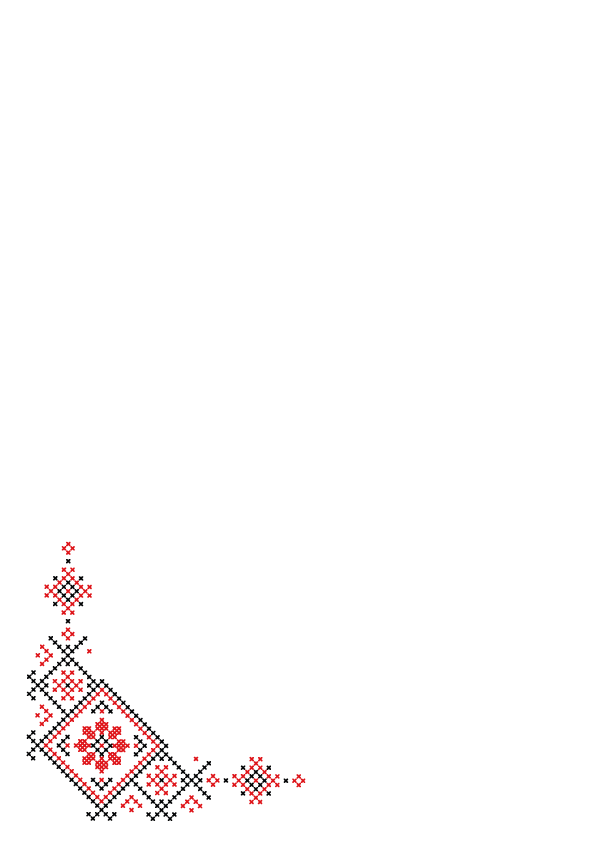 B ____ In embroidery there are certain types of stitches that people have used for centuries. They are the running stitch and the cross stitch. Some people say that in the old days people embroidered their shirts to protect themselves from evil spirits. So, they used a cross stitch to guard their necks, arms and chests.
B ____ In embroidery there are certain types of stitches that people have used for centuries. They are the running stitch and the cross stitch. Some people say that in the old days people embroidered their shirts to protect themselves from evil spirits. So, they used a cross stitch to guard their necks, arms and chests.
C ____ Embroidered shirts, blouses, tablecloths and towels are typical not only for Ukraine. You can find them in Hungary, Poland, Romania, Macedonia and many other countries. However, it has become more than just a traditional form of art only in Ukraine.
D ____ Nowadays, it is quite fashionable to wear vyshyvankas on holidays and for special celebrations. You can find people of different ages in Ukrainian traditional shirts. Some people wear them every day and have special vyshyvankas for holidays! The Vyshyvanka has become a symbol of Ukrainian identity. Today, people decorate not only shirts but also other clothes like blouses, T-shirts, belts, dresses, ties and even swimsuits.
E ____ Since 2008, there have been marches called Vyshyvanka Parades. They are usually organized on Sunday in May when the weather is already warm. You can see a lot of people dressed in different types of vyshyvankas. They go along the main streets of Ukrainian cities, sing songs and wish each other peace and happiness. They also carry the national flags of Ukraine and pictures of Taras Shevchenko, Ukraine’s national poet.
Task I. Read the text and match the titles (1 – 5) to the paragraph (A – E)
1. How is made.
2. Coming into fashion.
3. One of the oldest forms of art.
4. Marches in national clothes.
5. Embroidery around the world.
Task II. Read paragraphs A and B. Write the words under the correct headings.
|
bead decorate decoration embroider embroidery guard knit needle pattern protect sew thread |
|
VERBS |
NOUNS |
|
decorate |
|
|
|
|
|
|
|
|
|
|
|
|
|
|
|
|
Task III. Complete the sentences
1. I’m good at running s_______ .
2. We usually d_______ our classroom before major holidays.
3. In handicrafts lessons girls learn how to s_______, k_______ and e_______ .
4. My Granny taught me how to work with a n_______ and t_______ .
5. She decorated her blouse with coloured b_______.
6. I don’t like the p_______ on my sweater.
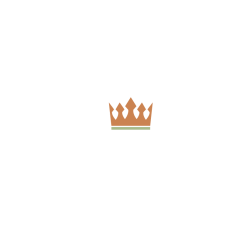 Anne of Kyiv
Anne of Kyiv
Queen of France
Not far from Paris there is a city called Senlis. In the city there is an old monastery with a church. There you can see a monument of a woman in a crown who is holding a small model of the church in her hands. This is the monument to Anne of Kyiv, the Queen of France. She was the youngest daughter of Yaroslav the Wise, the Grand Prince of Kyiv. She was born around 1024 and grew up in Kyiv. She was very beautiful and clever. In 1051 Henry I, the King of France, sent his men to Kyiv and asked Anne to marry him. She and her parents agreed and in spring 1051 she travelled to France.
She didn’t like the country at first but she liked the king and they got married on 19th May 1051. Their first son Philip was born on 23rd May 1052. Henry and Anne had three more children – Emma, Robert and Hugh.
Anne was well-educated. She could read and write in three languages but her husband and many of his barons couldn’t. They just signed all papers with a cross. As a Queen, Anne often signed official documents and she did it in her native language. In fact, her signature is the oldest example of old Ukrainian handwriting.
Anne called her first son Philip. That was a Greek name and the royal families of Europe didn’t use it as a name for their princes. Anne was the first to do so. Five more French kings had the same name.
When Henry I died on 4th August 1060, Philip was only eight. He was very young and his mother often helped the young king to make decisions and to rule the country. She spent a lot of time in the city of Senlis not far from Paris. In 1065 she ordered the building of a church and a church and a monastery there. She lived there for some time. Anne died in 1075. All the French kings after Henry I were related to Anne of Kyiv. In 2005 Ukraine gave a gift to the city of Senlis. It was a monument to Anne of Kyiv, the Queen of France. In 2013 the Ukrainian Cultural Centre of Queen Anne opened in Senlis.
Task I. How much do you know about Anne of Kyiv, the daughter of Yaroslav the Wise?
1. Anne was Yaroslav’s …
a) oldest daughter.
b) middle daughter.
c) youngest daughter.
2. She lived …
a) in the tenth century.
b) in the eleventh century.
c) in the twelfth century.
3. How many languages did she know?
a) three
b) four
c) five
Task II. Read the text again and answer the questions.
1. When was Anne of Kyiv born?
2. Who did she marry?
 3. What language did Anne use to sign official papers?
3. What language did Anne use to sign official papers?
4. How many Kings of France had the name Philip?
5. How old was Philip when he became king?
6. When did Anne died?
Task III. Say the dates from the text.
1024, 1051, 1052, 1060, 1075
Zaporizka Sich
A ______
Cossacks were first mentioned in writing in 1492. The word “Cossack” means a free and independent man. The original Cossacks were adventurous serfs who had run away from their masters and got together in the southern Ukrainian steppes in the 16th century, the Cossacks united in a military organization.
B______
The first fortifications built by the Cossacks were on Mala Khortytsia Island, in the lower part of the Dnipro, beyond the rapids – “za porogamy”. The word, “sich”, comes from the Ukrainian word “sikty”, meaning , “to chop up” or “to cut”. The Cossacks cut trees to make their fortifications from wood. Hence the name, Zaporizka Sich.
C______
The Cossacks lived in a strict military brotherhood in a no-man’s land between Poland, Muskoviia and the Crimean khanate. From the Sich they launched their raids against the Crimean Khanate and the Turkish Empire.
D ______
In 1648 the revolts of the Ukrainian peasantry and the Cossacks against the yoke of Poland led to the Cossack War. Led by Hetman Bohdan Khmelnytsky, the Cossacks won many victories over the Polish armies. The Yellow Water Battle and Korsun Battle of 1648 are part of the history of Ukraine and Cossack glory.
E ______
At that time Ukraine was squeezed between three great powers – Muskoviia, Poland and the Ottoman Empire. That was why it had to seek allies. At first Bohdan Khmelnytsky signed a peace treaty with the Polish king, but it did not work, because the Polish landlords kept possession of their Ukrainian land which caused more war between the Polish army and the Cossacks. Then, Bohdan Khmelnytsky agreed to place Ukraine under the protection of the Muskovite Tsar. The Treaty of Pereyaslav (Pereyaslavska Rada) concluded in 1654 and a new but gloomy chapter in the history of Ukraine began.
F ______
In 1667 Moscow and Warsaw divided Ukraine between them, whereby the Right Bank went to Poland and the Left Bank to Muskoviia. For the Ukrainian people it was a complete political disaster.
Task I. Read the text. Match headings 1 – 7 with paragraphs A – F. There is one heading that you don’t need.
1. Ukraine and its fighting for independence
2. Adventurous men
3. The division of Ukraine
4. Military brotherhood
5. The Treaty of Pereyaslav
6. The battles of Cossack glory
7. The first fortifications
Task II. Read and mark the sentences T (true) or F (False). Correct the false ones.
1. The word Cossack comes from the Ukrainian word “to cut up”
2. The Cossacks lived in a strict military brotherhood on land that belonged to Poland.
3. The war against Poland started in 1648.
4. The Treaty of Pereyaslav divided Ukraine between Poland and Muskovia.
5. The Yellow Water Battle and Korsun Battle of 1648 are part of the history of Ukraine and Cossack glory.
6. Cossacks were first mentioned in writing in 1654
Task III. Match the words/phrases from the text.
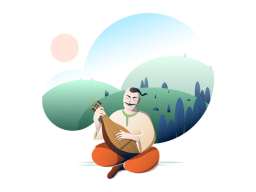 1 adventurous a allies
1 adventurous a allies
2 to launch b a treaty
3 military c serfs
4 to sign d brotherhood
5 to seek e disaster
6 complete f raids
Taras Shevchenko
Early Years
Task I. Read the text and choose the correct answer
Taras Shevchenko was born 1___ 9th March 1814. He was the third child in the family. His parents were serfs which meant that they ‘belonged’ to 2 ___ master.
However, his grandfathers and great grandfathers were Cossacks and were free 3___. And they fought for the freedom of their country.
When Taras was two, the family 4___ to the village where his father was from. There the boy 5___ his childhood.
At 6___ time people believed that the sky was lying on some ‘huge iron pillars’. When Taras was 7___ six he also heard such stories. So, one day the boy got out into the street and then 8___ along the road. He wanted to find where those pillars were. His parents and sister 9 ___ for him everywhere but they 10___ find him. Luckily, some merchants saw 11___ boy in the fields, took him with them and brought 12___ home. 13___ the age of eight he learnt to read and write and became interested in arts.
When Taras was nine his mother 14___ and two years 15 ___ the boy lost his father. That was the beginning of his long and difficult road to freedom.
1 a on b in c at
2 a her b their c his
3 a move b moved c moving
4 a men b man c women
5 a sent b spend c spent
6 a this b that c a
7 a about b on c at
8 a goes b went c goed
9 a looking b looked c look
10 a couldn’t b could c can’t
11 a a b ------- c the
12 a him b his c her
13 a In b On c At
14 a died b dead c dies
15 a ago b later c from
Task II. Answer the questions
1. When was Taras Shevchenko born?
2. Was he the only child in the family?
3. What does the word “serf” mean?
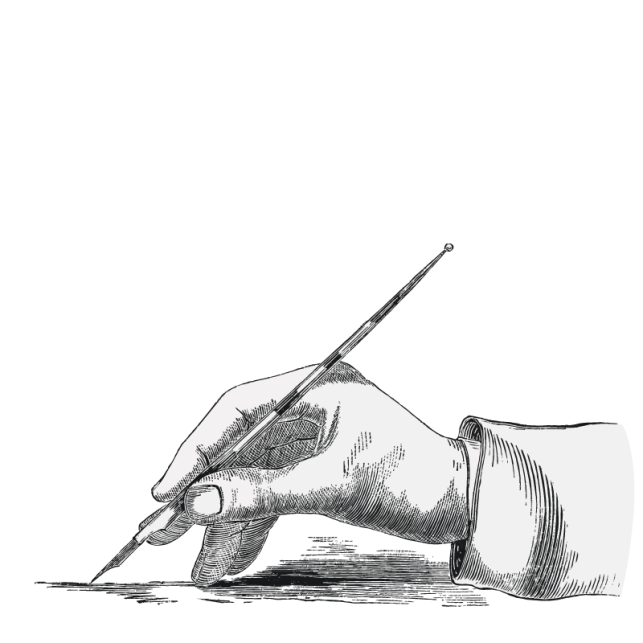 4. What were his ancestors?
4. What were his ancestors?
5.Where did Taras spend his childhood?
6. Why did he want to find ‘huge iron pillars’?
7. What age did he become interested in arts?
8. How old was Taras when he lost his parents?
9. Was his road to freedom long and difficult?
Combat Hopak
When people hear the word ‘hopak’ they may think of Ukrainian men in loose-fitting red or blue trousers dancing and kicking their legs to the side. Hopak is a traditional Ukrainian Cossack dance which goes back centuries. 1____ . This is also known as boyovy hopak or fighting hopak, and it is a modern type of martial art in Ukraine.
Combat hopak is a brainchild of Volodymyr Pylat, a former karate master. 2 ____ . He found, for example, that there were similarities between the famous hopak acrobatic jumps and the movements Cossack fighters made when they had to knock enemies off their horses or knock out two enemies at the same time. “I created combat hopak so that the Ukrainians have their own martial art; like the Koreans have tae kwon do and the Chinese have kung fu”, Pylat said.
In 1996, the first nationwide competition of combat hopak was held in Ukraine, and in 1997, it became a Ukrainian national sport. 3 ______ . To get through the first one, you have to work hard for two years and win 12 fights in Ukrainian competitions. You have also to do an ‘odnotan’. 4 ______ . combat hopak is very popular in Ukraine and there are almost 10.000 athletes all over the country. There are also combat hopak clubs in Canada, the USA and other countries. 5 ______ . It is very popular with children and there is even a special version of hopak for women, called ‘asgar’.
Combat hopak is an amazing way to train your body, but also to learn some things about the history and culture of Ukraine.
Read the text. Five sentences are missing. Match the sentences (A – F) to the gaps (1 – 5) . There is one extra sentence.
A Combat hopak has seven official levels of difficulty.
B It’s not just a man’s sport, either.
C He trains in combat hopak seven days a week.
D He saw that the hopak dance featured many fighting techniques.
E This a kind of dance you do on your own to show your combat hopak skills.
F However, ever since the 1980s there is kind of hopak: combat hopak.
Ukrainian National Dishes
One of the most enjoyable parts of travelling is a possibility to get to know better the local food. Ukrainian cuisine is incredibly diverse, and every region has its own specialties.
Ukrainian cuisine is safe for the stomach. In this respect, all the worries of those who visit Ukraine can be put at rest. The visitors can be sure that they are totally secure with Ukrainian food. Ukrainian cuisine, though it has some specific traits, is very similar to various European food. The ingredients are all the same: beef, pork, potato, chicken, beet, dough, milk and sour cream, cherry, apples, mushrooms and bread of course. The use of spices is moderate.
What best Ukrainian traditional foods do you know? Is it the borshch that first pops up in your head? No doubt, it is the main representative of Ukrainian culinary talents abroad. However, Ukrainian cuisine extends much farther than that!
From the borsch to the uzvar – here are some mouthwatering dishes you should try when visiting Ukraine.
We absolutely have to start with borshch! This traditional soup, made out of beet root and up to 20 other ingredients, is a staple dish in every Ukrainian family. We love our borshch with all the depth of our Ukrainian hearts – hot and cold, fresh and stale, for lunch or for breakfast, as a meal or even as a healing medicine against the winter colds. Every housewife has her own secret version of borshch.
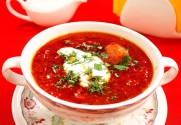
Traditionally borshch recipe is a basic stir-fry of grated beet root with tomatoes, added to a generous soup of vegetables – onions, carrots, fresh or pickled cabbage, peppers, and whatever else is available from our house garden.
For the true state-of-art samples of this dish you have to head to the hidden-away villages of Carpathian Mountains, where borshch is cooked not on the gas stove, but is left to simmer for hours in the coziness of wooden oven. Pour it in the clay pot, drip in a spoon of fresh sour cream, snack up on a garlic-sprinkled pampushky and you’ll be able to understand what the true Ukrainian heaven looks like!
Your journey to Ukraine won’t be complete without trying this tasty and nourishing soup!
Salo
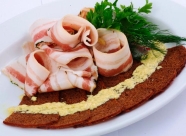
The description of Ukrainian cuisine would be incomplete without salo (pork fat). Ukrainians regularly joke, "Salo is our national pride". Placing a thin slice of salo on black bread with garlic and salt is a quick and simple way to a delicious snack. Salo (bacon, lard) occupies a special place in the Ukrainian cuisine. We just love it, especially on a piece of homemade bread with a clove of garlic. That’s why we don’t understand why some foreigners find it strange or even unsavory to eat fresh raw lard… However, if you are not ready to have a bite of salo, you should at least try it in a form of mousse, whipped with herbs and spices. This appetizer is often served in the Ukrainian traditional restaurants.
However, it is proved that salo is a healthy product, which can even prevent atherosclerosis.
BREAD
Bread is definitely a staple Ukrainian food. Its significance oversteps simple nourishing merits: bread is regarded as a holy gift of God, and all Ukrainian traditional celebrations include bread as an object of reverence.
It is hard to name a nation that would respect bread as much as Ukrainians do. Bread was regarded as one of the holiest foods.
At gatherings hosts often give their guests a loaf of bread with salt on top. The ritual of offering bread and salt to guests is a ceremony of welcoming which dates back many centuries. "The Bread and Salt" tradition is very symbolic in Slavic culture and can symbolize many things. During wedding ceremonies in Ukraine it is customary to serve traditional bread called Korovai instead of a wedding cake. It symbolizes a new-family birth and its future prosperity
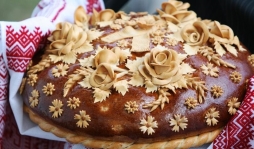
The famous Ukrainian Easter dish is ‘paska’. This sweet egg bread is the rightful companion of the grand meat sausage. Paska is the favorite staple of Ukrainian Easter breakfast tables and is loved by both adults and children. Baked in dozens, it’s a popular give-away during Easter family visits.
Curiously enough, one has got to try 12 different paskas for Easter to get plenty of good luck for the next year. And the task could not be easier!
This mouth-watering bread is made of eggs, flour, sugar, butter and yeast. The best paskas are usually baked in wooden ovens, and with as little disturbances as possible.
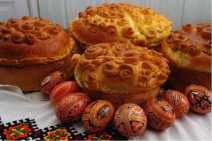
Great Ukrainian housewives instruct that during the baking of paska, no one should be allowed into the kitchen, except the housewife herself – to avoid the unnecessary noise and not to distract the bread from molding up into the most delicious pastry of Ukrainians. Keep in mind that paska is baked only once a year, on Orthodox Easter!
VARENYKY
Another must-try dish in Ukraine is vareniki. Just like borshch, traditional dumplings spearheaded the voyage of Ukrainian cuisine across the globe. Combined with the piping-hot plate of borshch, those two are Ukrainians’ food of choice in sickness and in health.
Conveniently varenyky can be made out of the cheapest ingredients available. Dough is a simple mix of flour, water and salt. And stuffing can be anything: from mashed potatoes with mushrooms and fried onions, pickled cabbage, minced meat and even cherries or other berries!
Varenyky can be simply described as boiled dumplings with different fillings: potatoes, cottage cheese, meat, liver, even cherries or bilberries. The sweet version of varenyky is usually served with sour cream and honey, and is a tasty and healthy substitute for the calorie-counting sweets lovers. So, the choice is up to you!
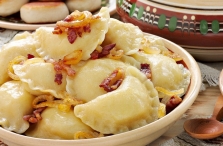
HOLUBTSI
This dish is very popular in Ukraine, though it is not easy to cook. First, you have to prepare the stuffing – a mixture of rice, onion, carrot and forcemeat, and then you need to wrap it into boiled cabbage leaves. When the preparation is done, you should simmer the holubtsy for about an hour in a tomato souse. This is so yummy! 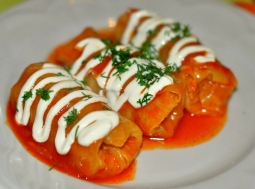
BANOSH WITH BRYNZA
The highlands of Carpathian Mountains are revered to as the kingdom of Ukraine’s most luscious dishes. Bordering with no less than 4 countries (Romania, Slovakia, Hungary, and Moldova), Carpathian cuisine brings together the best tastes of each land. However, region’s most famous contribution to Ukrainian menu is banosh.
This traditional food of highland shepherds is essentially corn flour, cooked in sour cream, with the tasty additions of brynza – local salty sheep cheese, wild white mushrooms (preferably hand-picked from the nearest forest!) and shkvarky (scrunchy bits of pork fat). Those, caring about the calories, can easily omit the last one. The true banosh is cooked on fire, thousands of meters above the sea level in the midst of impressive Carpathian peaks and flourishing valleys, and always by men.
UZVAR
Uzvar is traditional Ukrainian drink of choice! It’s regularly cooked in the local households. This refreshing beverage is actually a compote, made out of dried fruits. Most popular ingredients are dried apples, pears and apricots, with some prunes, raisins and honey to sweeten the already savory drink.
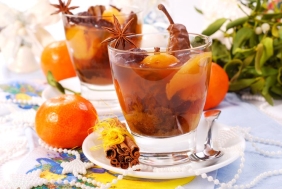
Ukrainian food and cuisine is famous for its variety, nutritive value, and, to be perfectly frank, its deliciousness.
Notwithstanding increasing interest in Asian and European cuisines, traditional Ukrainian dishes remain to be the most popular food of local people, which is proved by innumerable amount of Ukrainian restaurants, fast-foods, kolybas etc.
Ukrainian food and cuisine traditions are formed due to the favorable geographic position (Ukraine has an exceptionally fertile soil – chornozem) and climate conditions perfect for cultivation of various grains and plants and animal domestication. It is also influenced by foreign cuisines as a result of numerous conquests and trade relationships within its long history.
Be sure to try all these tasty dishes during your stay in Ukraine – the delight and satisfaction are guaranteed! So, as the saying goes - when in Ukraine, dine as the Ukrainians do!
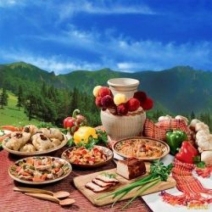
Task I. Complete the sentences using appropriate words and phrases:
1. Ukrainian cuisine is incredibly _____ .
a) identical
b) diverse
c) the same in all parts of Ukraine
2. When visiting Ukraine you should try _____ .
a) only borshch
b) different national dishes
c) borshch and varenyky
3. The traditional borshch is _____ .
a) a staple dish in every Ukrainian family
b) cooked only in the Carpathian region
c) eaten only with garlic
4. It is considered to say ______ .
a) “Salo is Ukrainian national pride”
b) “Salo is eaten only by adults”
c) “Salo is unhealthy food”
5. All Ukrainian traditional celebrations include _____ as an object of reverence.
a) bread
b) pampushky
c) cake
6. _____ can be described as boiled dumplings with different fillings.
a) Varenyky
b) Halushky
c) Noodles
7. It is necessary to _____ holubtsi.
a) boil
b) simmer
c) bake
8. Uzvar is made out of _____ .
a) dried fruits
b) fresh fruits
c) steamed fruits
Task II. Answer the questions.
1. What best Ukrainian traditional foods do you know?
2. What dish is the main representative of Ukrainian culinary talents abroad?
3. What are the main ingredients of Ukrainian borshch?
4. What product occupies a special place in the Ukrainian cuisine?
5. What food is regarded as a holy gift of God for the Ukrainians?
6. What does the ritual of offering bread and salt to guests mean?
7. What does traditional bread called Korovai symbolize?
8. What are the peculiarities of baking Paska in Ukraine?
9. What dish is made of mix of flour, water and salt?
10. What dish from the highlands of Carpathian Mountains made the most famous contribution to Ukrainian menu?
11. What is traditional Ukrainian drink?
12. Comment the saying “When in Ukraine, dine as the Ukrainians do”.
Wake Up, the War Has Begun!
February 24, 2022 forever divided the lives of Ukrainians before and after. At five o'clock in the morning, russian troops launched a massive air attack throughout Ukraine and launched a full-scale military offensive. During the eight years of terror in Donbass and the occupation of Crimea, the cannibalistic appetite of the aggressor's country has grown.
The russian army inflicts insidious attacks on civilian facilities, medical facilities and schools, destroys Ukrainian cities, shells green evacuation corridors, regularly disregards the 1949 Geneva Convention relative to the Protection of Civilian Persons in Time of War, and commits war crimes by cynically killing Ukrainians. According to the UN, 60% of Ukrainian children were forced to leave their homes due to military action by the russian side.
Hoping for a quick victory, “inthreedays”, the troops of the invaders encountered strong opposition from Ukrainians, who zealously defend their land, freedom and independence, despite the fact that ordinary life is collapsing before our eyes.
Today, Ukrainians are united as never before - they stop tanks and armored personnel carriers barehanded, go to strikes in the occupied cities, because they cannot humbly remain silent. Every Ukrainian on his front is selflessly fighting for his country as a volunteer, journalist, hacker, cook, driver, artist and so on. The war wiped out all shaky construction that brought disunity, and the awareness of Ukrainian identity inevitably crystallized in every citizen of Ukraine.
Glory to Ukraine!
How to Talk About War
Useful Words and Phrases
- armed forces (of Ukraine) - Збройні сили (України)
- warfare /ˈwɔːr.fer/ - військова справа, військовий
- manpower - людські ресурси
- martial law - воєнний стан
- defense - захист
- casualties - жертви
- mercenaries /ˈmɝː.sən.ri/ - найманці
- utter defeat - повна поразка
- troops - армія
- elimination - ліквідація
- territorial defence - територіальна оборона
- full-scale invasion - повномасштабне вторгнення
- curfew - комендантська година
- shelling - обстріли
- (bomb) shelter - бомбосховище, безпечне місце
- strategic assets - стратегічні об’єкти
- rescuers - рятувальники
- conscript - призовник
- morаle - бойовий дух
- be hailed as a hero - бути визнаним героєм
- Air raid siren - повітряна тривога
- looting - мародерство
- firing squad - розстріл
- genocide /ˈdʒen.ə.saɪd/ - геноцид
- mass graves - братські могили
- occupation /ˌɑː.kjəˈpeɪ.ʃən/ - окупація
- invaders - окупанти, загарбники
- captive - полонений
- abducted - викрадений, захоплений
- hostile – ворожий
- civilians - мирні жителі
- flee abroad - тікати за кордон
- flee empty-handed - тікати без речей
- rent -винаймати, орендувати
- forced trip - вимушена поїздка
- aid - допомогти
- temporary protection - тимчасовий захист
- refugee status /ˌref.jəˈdʒiː/ - статус біженця
- internally displaced person (IDP) - тимчасово переміщена особа
- obtained the status - отримати статус
- social benefits - соціальні виплати
- identification documents - документи, що посвідчують особу
- birth certificate - свідоцтво про народження
- foreign passport - закордонний паспорт
- checkpoint - блокпост, контрольно-пропускний пункт
- bug-out bag - тривожна валіза
- border guard - прикордонник
- refugee camp - табір для біженців
- emigration - еміграція, переселення
- rescue /ˈres.kjuː/ - порятунок
- accommodation - нічліг, місце для ночівлі
- reception point - пункт прийому біженців
- apply for asylum /əˈsaɪ.ləm/ - просити притулок
- evacuation train - евакуаційний поїзд
- homesickness - туга за домом
- refugee syndrome - синдром біженця
- look for a job - шукати роботу
- temporary job - тимчасова робота
- avoid danger - уникнути небезпеки
- cross to neighbouring countries - переїхати у сусідні країни
- queues at the border - черги на кордоні
- legally - легально
- be given food and medical care - отримувати їжу і медичну допомогу
- rent-free - без орендної плати
- be vetted - пройти перевірку
Glory to Ukrаine! - Слава Україні!
Glory to the heroes! - Героям слава!
Glory to the Nation! - Слава нації!
Death to the enemies! - Смерть ворогам!
Good evening, we are from Ukraine - Доброго вечора, ми з України
Russian warship, go away - російський військовий корабель, іди до біса!
Ukrаine is a European country - Україна - це Європа
Stand with Ukraine - Бути з Україною, підтримувати
Life will win over death, and light will win over darkness - Життя переможе смерть, а світло - темряву.
Our Mriya will never perish! - Нашу Мрію не знищити!
Be brave like Ukraine - Будь сміливим як Україна.


про публікацію авторської розробки
Додати розробку
